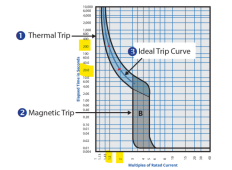jabbles
New Member
I want to put a circuit breaker on my inverter output to trip the power at 1000W load and also so that I can use it as an on/off switch
1000W @ 220V -> 5A
So I go find a 5A AC circuit breaker, doesn't need massive kA rating since its not for short-circuit protection
But then I read about the "curve type" of circuit breakers
Does this mean a 5A circuit breaker doesn't actually trip when the current hits 5A?
1000W @ 220V -> 5A
So I go find a 5A AC circuit breaker, doesn't need massive kA rating since its not for short-circuit protection
But then I read about the "curve type" of circuit breakers
B Curve means the MCB trips between 3-5 times full load current. It is mainly used in residential applications where loads are resistive e.g. lighting fixtures, domestic appliances with low surge Levels.
C Curve means the MCB trips between 5-10 times full load current. It is used in commercial/industrial applications where there is greater chances of higher short circuit currents e.g. mainly inductive loads , fluorescent lighting.
D Curve means the MCB trips between 10-14 times full load current. It is used where inrush currents can be very high e.g. motors, X-ray machines.
Does this mean a 5A circuit breaker doesn't actually trip when the current hits 5A?







